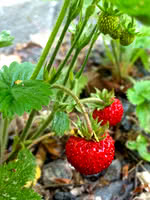Mon-Fri 9am - 5pm Mountain time
Wild Strawberry vs Bilberry
Vaccinium myrtillus
Fragaria virginiana
CUSTOM GROW
Bilberry is a native perennial shrub valued for its small, blue-black berries that ripen in mid to late summer. The berries resemble blueberries but have a richer, more tart, and intense flavor. They have long been used for fresh eating, baking, and preserves, while also providing food for birds and mammals. In spring, its delicate pinkish flowers attract bees and other pollinators.
Growing low to the ground, Bilberry forms spreading colonies that create dense understory cover. This growth habit provides food and shelter for wildlife, and its foliage adds seasonal interest by turning red to purple in autumn. With its adaptability and ecological benefits, Bilberry is well-suited for naturalization, ecological restoration, and pollinator gardens.
Often called the Woodland Strawberry, the Wild Strawberry produces a sweet, edible red berry all throughout the later spring and summer. This compact, stemless plant spreads mostly through the means of runners, and grows quickly.
Flowers and fruit of the Wild Strawberry are usually present simultaneously throughout the summer. This variety is native to North America, which gives it its name.
Bilberry Quick Facts
Wild Strawberry Quick Facts
Toxicity: leaves may be unsafe in high doses

